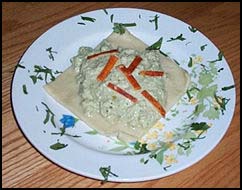Pumpkin Ravioli Californian with Pipian
We were being soooo Californian, combining elements of Italian and Mexican cuisines, a different sort of East Meets West. The Silichef ingredient, pumpkin, just screamed for this sort of treatment. After all, squash ravioli in butter and sage is an Italian classic, so there’s half the battle. But since pumpkin is All-American, we thought that we ought to use All-American flavors and styles. That’s the other half. In our humble opinion, this tasted spectacular.
The pipian could be used in quite a few other ways. Ditto the pasta.
Pasta
3/4 c cake flour
1/2 c “Better for Bread” flour
1/2 c masa harina
1/2 tsp salt
2 large eggs
Mix dry ingredients, make into a well. Add eggs into the well, then mix them pretty vigorously with a fork, allowing the flour to fall in from the sides of the well as the mixing progresses. As the eggs distribute, use your hands to bring the dough together. On a floured board, knead the dough until it is smooth and elastic, adding cake flour as needed to prevent sticking and adjust the moistness. Form the dough into a ball, wrap in plastic wrap and set it aside to rest.
Pipian
2/3 c raw hulled pepitas
4-5 cloves garlic, unpeeled
6-8 small tomatillos
1 coarsely chopped serrano chile, with seeds
2/3 c extra-virgin olive oil (I used Napa)
2-3 pinches of coarse-ground black pepper
1/3 c crumbled queso seco
2-3 pinches salt
1/2 c coarsely chopped cilantro, loosely packed
1/2 lime
Heat up a dry pan over a medium to medium-high flame. When hot enough for water drops to immediately hiss away, put garlic cloves on pan and allow to roast, turning every few minutes. They’re done when they’ve got black spots on at least two sided. Set aside to cool. Put the pepitas in the pan and roast them with frequent stirring until they start to brown and are popping and sizzling. Put aside to cool.
Heat up broiler. Take paper off and rinse tomatillos. Dry them off, then broil on two sides until black spots appear. Place in a bowl to cool slightly, then trim off the little hard parts where the stems were.
Add garlic, pepitas, tomatillos, and serrano to a food processor or blender. While pulsing it to make a coarse puree, pour in the olive oil, add the pepper, then the cheese and the salt. You want a consistency like that of a coarse, creamy pesto. Now add the cilantro and the juice from the lime half, then process to a refined pesto texture- you”re looking for the flavors to be well-mixed, but the sauce to have some textural interest. You should still see flecks of green cilantro. Adjust salt and acidity.
Filling
1 medium-sized green Japanese pumpkin
1/2 c (or maybe a little more) grated, loosely-packed queso anejo
1 egg
1/4 c breadcrumbs
pinch of salt
pinch of black pepper
Cut pumpkin in half, scoop out seeds and pulp. Mail them to your congressman. Face pumpkin halves down on a cookie sheet, then roast for 45 minutes or so in a 350º oven. Scoop out the guts into a bowl, mash coarsely, and put aside to cool down a bit. Add the rest of the ingredients, then blend with a fork until homogeneous.
Assembly

Start heating a very large pot of salted water. Roll out the pasta dough, fill as you would any ravioli. Ours was a little thicker than it should have been- on my Atlas machine, it was a four. A five would be better. Make a few big ones rather than many small ones, if you like that sort of presentation (we do; it shouldn’t look Italian). Save the pasta trimmings. Drop ravioli into the boiling water, add some of the doubled-over trimmings and cook until done. Use the trimmings as a tasting guide to determine if the pasta is done. Don’t make the mistake I used to with home-made pasta and undercook it- you want it to be very well-cooked, so that there’s no whitish core when a bite is taken from the doubled trimming. At the point where that white core disappears, you’re done. In our case, it was about 10 minutes. Drain.
Serving Option One
If you like huge, full-bore flavor, use this option. Plate a ravioli, then spoon the pipian over it.
Serving Option Two
For the shyer and more-refined, spoon some boiling stock onto the plate (I’d use a corn stock made from a browned mirepoix and corn cobs, if I had it). Place the ravioli on the plate, spoon a bit of stock over it to moisten, then place a blob of pipian on top. When eating, you”ll stir the pipian into the stock in the manner of a pistou.
Both Options
Garnish with matchsticks of queso anejo and a cilantro chiffonade. A tablespoon of salsa of roasted and diced poblano and red bell pepper on the side of the plate would make a nice color contrast.
Click to print this recipe as a PDF.